Television Age
Television Age was a Japanese monthly magazine published by Shiki Shuppan from the mid-1960s to 1980, subtitled "The specialised magazine for foreign TV and movies". It had 50 pages, with a colour cover and black and white pages; the first and last 8 pages were glossy paper and largely photographic, the interiors with more text. Unlike most Japanese books, the spine is on the left, like a western book, reflecting the subject matter. It features mostly American TV stars, particularly of western, police, adventure and science fiction series.
Two issues had UFO covers (January and February 1976), and Martin Landau appears on one cover (April 1976), but in a Mission Impossible shot.
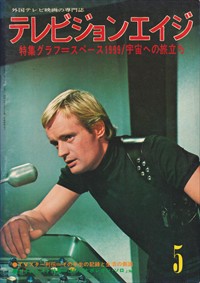
The following is the May 1977 issue, just after Space: 1999 started in Japan in April 1977. The series is listed on the cover under the title.
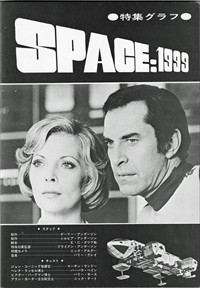
"Special feature Space: 1999" front page. Staff and crew are listed with some odd attributions: creators Gerry and Sylvia Anderson, stories by E.C.Tubb and others, special effects director Brian Anderson, effects camera Nick Alder, music Barry Gray. Landau, Bain, Morse and Tate are listed as cast.
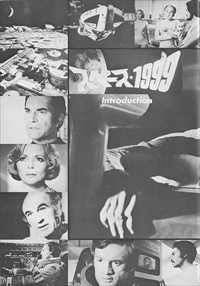
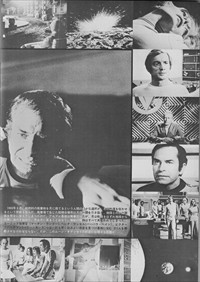
Introduction
In September 1999, a foolish decision by humans to dump nuclear fuel waste on the moon led to a tragedy that disrupted the moon's orbit. A nuclear fusion explosion at the dump tore off part of the moon, completely changing its gravitational relationship with the Earth. Alpha Base was safe, but the moon lost its orbit and began to move away from the Earth. The moon will never return to its original state, and all hope of help is lost. Commander Koenig (Martin Landau), Helena Russell (Barbara Bain), Victor Bergman (Barry Morse) and others must find a habitable planet as soon as possible and move the 311 people living at the base. However, there are many difficulties ahead of this Moon Odyssey...
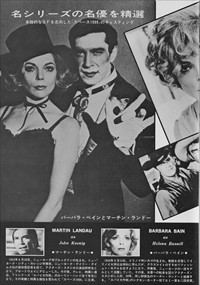
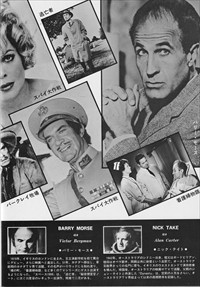
A selection of famous actors from famous series
Casting for "Space 1999" aims for serious science fiction
MARTIN LANDAU as John Koenig
Born June 30, 1933 in Brooklyn, New York. After graduating from New York City College, he worked as an art department reporter for the New York Daily Times before becoming an acting trainee at the Actors Studio and making his Broadway debut. He then moved on to television and film, becoming famous for his role as Rollin Hand in the TV series "Mission: Impossible," and was awarded the lead role in "Space 1999" due to his achievements and unique personality.
BARBARA BAIN as Helena Russell
Born September 13, 1934 in Chicago, Illinois. She studied sociology at the University of Illinois with the aim of becoming a teacher, but a classmate suggested she become a fashion model, and after graduating, she worked as a top model in New York. She then decided to become an actress and joined the Actors Studio, and in 1959 she married fellow trainee Martin Landau. She won two Emmy Awards for her role as Cinnamon Carter in "Mission: Impossible."
BARRY MORSE as Victor Bergman
Born in London, England in 1919, he graduated from the Royal Academy of Dramatic Art, where he made his stage debut and then moved into film. In 1951, he moved to Canada and was active in the early days of Canadian TV. His fame spread to Hollywood, and he began making guest appearances in many TV series, including "The Naked City" and "Nurse's Story." "Space" was his third regular appearance, following "The Fugitive" and "Notes to a Secret Agent." He is married and has two children.
NICK TATE as Alan Carter
Misspelled "Nick Take" in English, but the Japanese version is correct
Born in Sydney, Australia in 1942. With a grandfather who was a vaudeville performer, a grandmother who was an opera singer, and both parents being actors, he grew up in one of the most prestigious families in the Australian entertainment industry and trained in acting in the West End in the UK. After returning to Australia, he worked in Australian films and TV, and co-starred with his father, John Tate, in the TV series Dynasty, which garnered unprecedented popularity and recorded the highest audience ratings in the history of Australian TV.
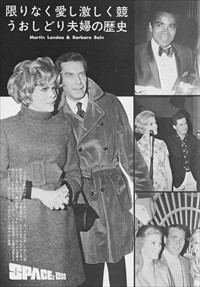
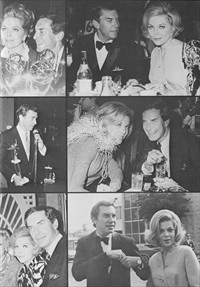
The history of a loving couple who love each other so much and compete so fiercely
Martin Landau & Barbara Bain
The reason for this is to create a good atmosphere, and conversely, it is proof of how close they are. However, this seems to suggest that they are mixing up their private and professional lives, but contrary to expectations, they are dressing up, eating together, and sharing the same meal, which only strengthened the impression. They are a well-known and popular lovey-dovey couple. They are also appearing together in their second film series after "Mission: Impossible".
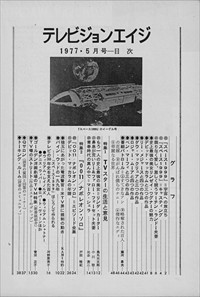
Table of contents (which appears after the glossy feature pages). The photo is captioned "The Eagle from Space 1999". Other articles are on Lindsay Wagner, David McCallum, Lee Majors, Doug McClure, Roger Moore and Ben Murphy. There is an episode guide to "Napoleon Solo".
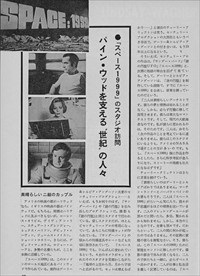
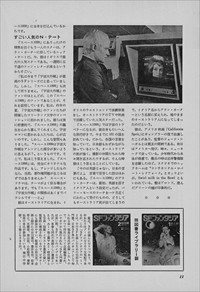
Pinewood 1999. This is how Space: 1999 was made.
A visit to the Space 1999 studio
If Hollywood is the capital of American cinema, then Pinewood is the capital of British cinema. Of course, it cannot compare to Hollywood in scale, but many great actors, including Laurence Olivier, Vivien Leigh, Stuart Granger, Rex Harrison, David Niven, James Mason, Sean Connery, and even David McCallum and Roger Moore, used Pinewood as their base of operations.
Century 21 Productions, run by husband and wife duo Gerry and Sylvia Anderson, is the name you're probably familiar with. It's the production company that brought you Thunderbirds and UFO. Filming also took place in the same studio as UFO. Although it's a rented studio, it's almost exclusively for Century 21 Productions, with special effects sets constructed here and there. Special effects props and scenes from the Thunderbirds days have been carefully preserved, and apparently they were used frequently in Space 1999.
The company changed its name from APF to Century 21 to Group 3. Effects were filmed at Bray studios, not Pinewood. Thunderbirds was filmed in Slough, and no props were used in Space 1999, although some music cues were recycled.
"It was a long time coming," says director Charlie Crichton, laughing. He is one of the pillars of Century 21 Productions and has been working with Gerry and Sylvia Anderson for over 15 years. "As the project spreads from the sky above the Earth to the moon and from the moon to space, the number of sets will increase."
Come to think of it, Century 21 Productions' works have been gradually expanding the scope of their stories, such as Thunderbirds, UFO, and Space 1999. And it seems that Gerry and Sylvia Anderson had already planned and written the original story for Space 1999 when they were producing UFO.
"They are both wonderful artists. Their dreams and passion never die, and they always take action to make them a reality. They are great romantics, and modern-day voyagers. That's why I'm attracted to them. They must be thinking about their next work. They spend more time at NASA in the United States than here in this studio. If they were to make another work after Space 1999, the scientific research would be even more meticulous and the story would be on a grander scale."
Charlie Crichton continues: "It's not just Gerry and Sylvia who are wonderful. Martin Landau and Barbara Bain are also wonderful. They love Space 1999 and are so passionate about it that it's almost surprising. You might be surprised to hear that they have separate dressing rooms, but it's true. They even eat separately. But that doesn't mean that something's happened between them. Just look at them at home. Yes, they moved their home to London for Space 1999. Whenever they have a long break from filming, they always go to Penn State with their two children. The reason they strictly separate their work and private lives is because they're working on Space 1999.
Another star who pours all his energy into Space 1999 is Nick Tate, who plays Alan Carter. He is now the biggest star in the UK, and receives an incredible 5,000 fan letters a week.
"Until now, I have thought that Star Trek was the best sci-fi series, but Space 1999 is by no means inferior. The fact that most fans of Star Trek are also fans of Space 1999 proves this. Last summer, I was invited to a competition at the University of Maryland held by fans of Star Trek. They were very enthusiastic and genuinely happy about the birth of Space 1999. People who are attracted to space romance are very open-minded."
This dates the interview to late 1976, during filming of the second series.
However, I was asked the following question: "Doesn't Space 1999 seem to have adapted many parts of Star Trek?" To which he replied, "Space 1999 is a completely original work. If it is an adaptation, surely there should be copyright issues? Space dramas can often have similar themes. But Space 1999 and the relationship between Star Trek and Space: 1999 is purely parallel..."
He was born in Australia and trained in theatre in the West End of Australia and was a popular star on Australian TV and in films.
In Space: 1999 he plays a space traveller, but he himself is a big travel enthusiast and has visited 101 countries so far. Therefore, he knows the language of each country and knows a little bit of Japanese. He has a strong Australian accent, and sometimes his colleagues on the set ask him to repeat himself, but when that happens he answers like this:"That's not English. It's Japanese." .
There are other stories of language difficulties. Alan Carter in Space: 1999 was originally meant to be an Italian who spoke English, but after nearly a month of coaching from Barry Morse, he couldn't help but speak with an Australian accent. So his Italian name was changed to Alan Carter and he became a true Australian.
He appeared in the American movie California Split as a gambler, and is good friends with the director, George Segal. He flies to America on his days off, and sometimes meets up with Segal in New York. He has been a good swimmer since he was a boy, and when he was drafted, he volunteered for the Coast Guard. His nickname at the studio is "Continental Robert Redford," which sounds cool, but he is also known as "Swirl milk in the bowl." He has blonde hair and striking, clear green eyes.
Tate isn't credited in California Split (1974), and we haven't spotted him
There is also a book review of the science fiction compilations "science fiction fantasia" edited by Fukushima Masami.